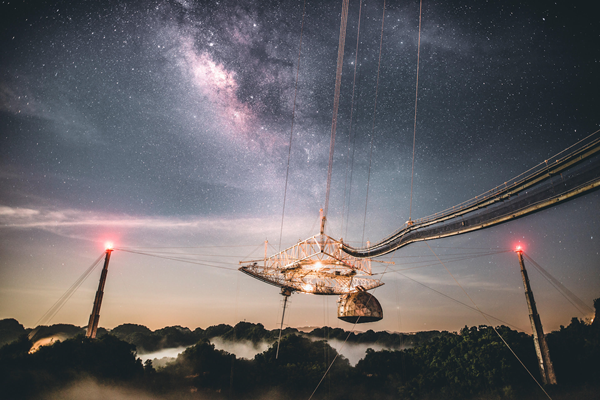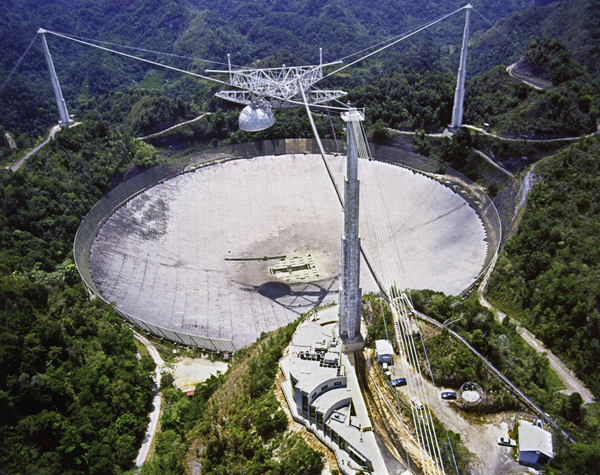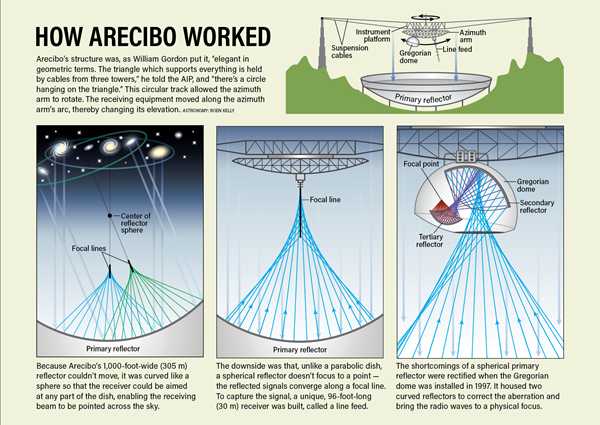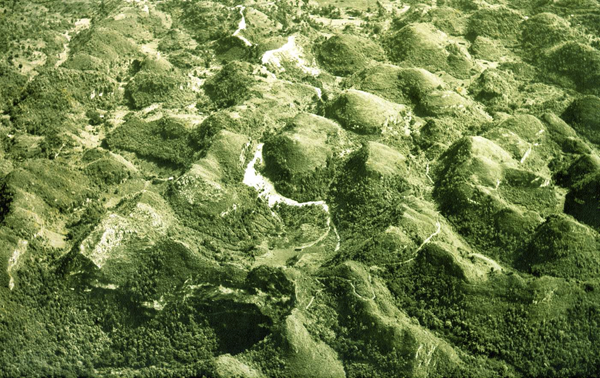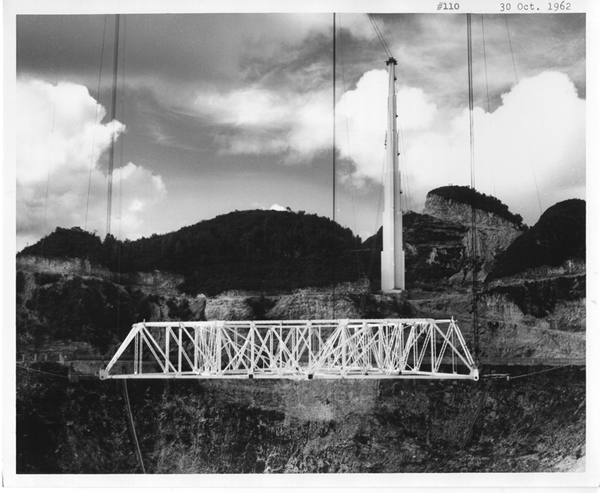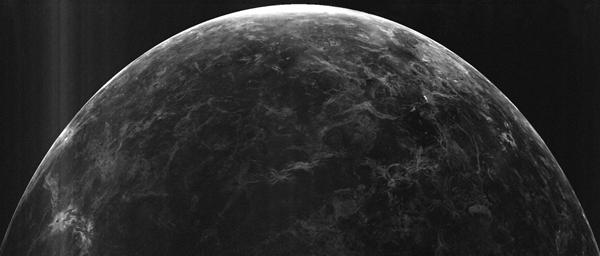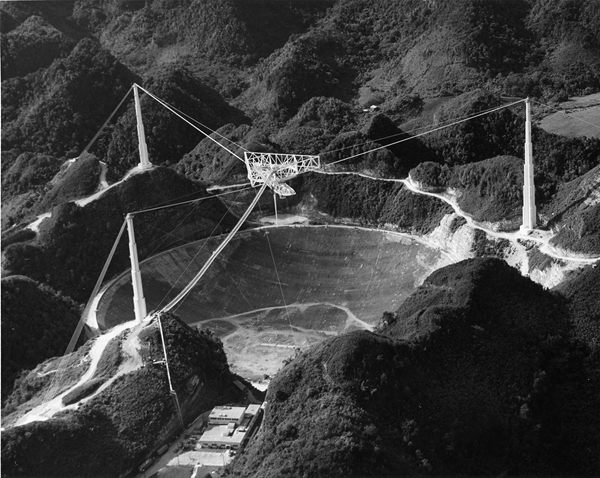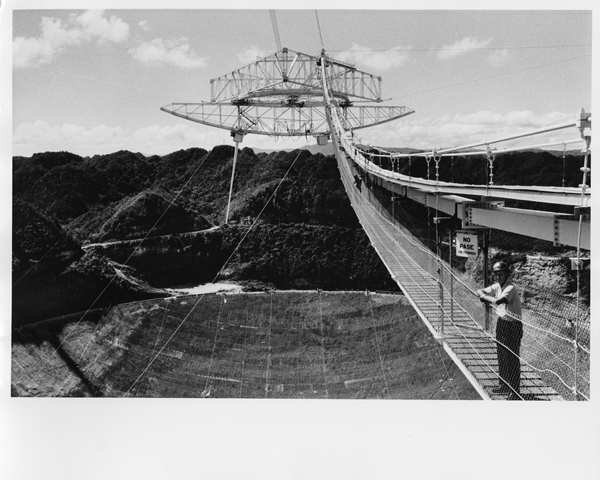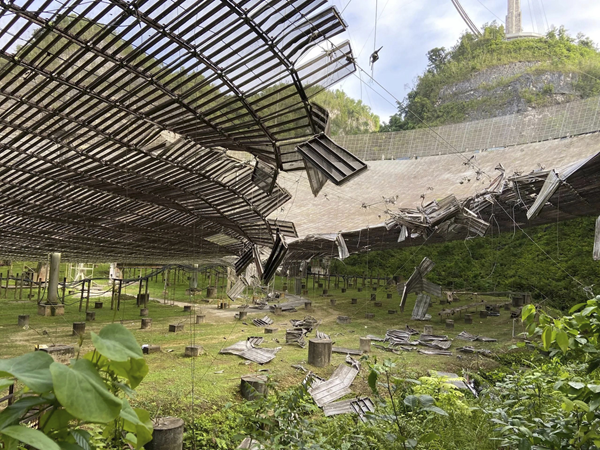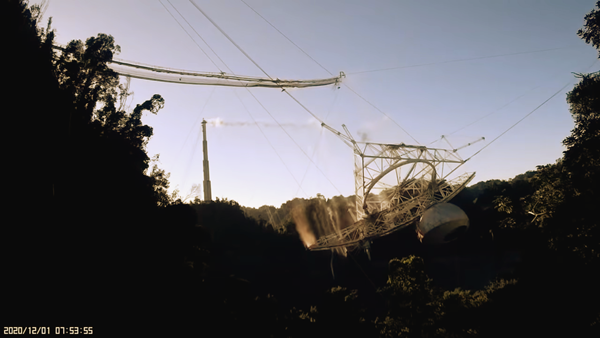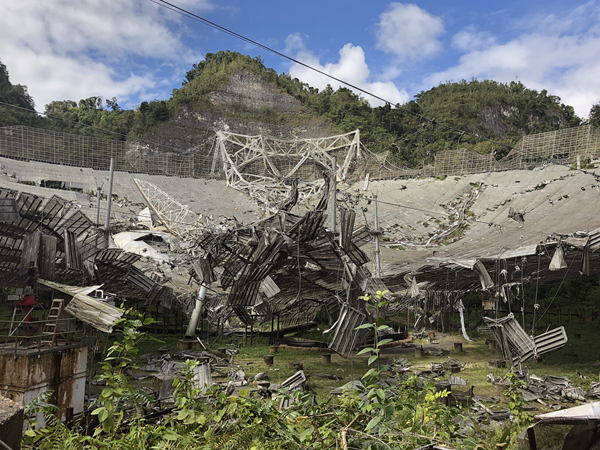Upon opening in 1963, the telescope was called the Arecibo Ionosphere Observatory. Conceived by Cornell University electrical engineer William Gordon as an enormous radar to study the ionosphere, the facility was managed by Cornell and funded by the U.S. military’s Advanced Research Projects Agency (ARPA), which was interested in using it to track nuclear missile launches. That Arecibo would become the world’s most iconic radio telescope, discovering exotic stars and alien worlds, was almost an accident of history.
Astronomy talked to Arecibo researchers who worked at the telescope throughout its long history. Pioneering figures Gordon and astrophysicist Thomas Gold are no longer alive, but their voices appear here thanks to oral histories archived at the Niels Bohr Library at the American Institute of Physics (AIP). All interviews have been condensed and lightly edited for clarity.
When we were talking about building it back in the late ’50s, we were told by eminent authorities it couldn’t be done. We were in the position of trying to do something that was impossible. It took a lot of guts. We were young enough that we didn’t know we couldn’t do it.
Daniel Altschuler, former Arecibo director: People came to look at the wonder. You know, it had these three towers pointing at the sky. To me, it was like a cathedral to science.
Abel Méndez, planetary astrobiologist, University of Puerto Rico, Arecibo: In The Avengers, there’s a thing that one of the Avengers says to intimidate: “We have a Hulk!” For Puerto Rico, it’s: “We have Arecibo!” Something to brag about, something to feel confident about. Puerto Ricans feel quite proud of the observatory.
The early years
Gordon (1994): Honestly, the observatory was built to study the upper atmosphere. Radar astronomy and radio astronomy were essentially fringe benefits.
Donald Campbell, former Arecibo director: ARPA was interested in trying to figure out ways to detect incoming nuclear missiles by a wake that they might leave in the ionosphere. But even ARPA realized fairly early on while the telescope was being built that this probably wasn’t going to be terribly useful [for detecting nuclear missiles] — as it wasn’t, by the way.
While Gordon was primarily interested in studying the upper atmosphere, radio astronomers were intrigued as well. The field was still in its infancy, and the prospect of a facility as powerful as Arecibo drew attention. In 1959, Cornell’s Dean of Engineering Dale Corson lured the brash British astrophysicist Thomas Gold from Harvard University to run a burgeoning astronomy program that would include overseeing Arecibo.
Thomas Gold (1978): Bill Gordon unfortunately didn’t take kindly to that.
Gordon: It was a matter of who was in control, I guess.
Gold: It’s all very well to be responsible for the construction, but we had to build up teams of people to operate the thing and to use it for the many different purposes for which it could be used, including radio astronomy, which Bill Gordon knew nothing about.
Gordon: It was Corson who finally, in 1965, asked me to come back to Cornell. If you ask me, I was mad at the time. I thought I was removed from a job that I deserved to have. I’m sure that Gold had talked him into it.
Gold is a very bright guy. He’s cunning. He has lots of good ideas. Wait a minute. He has lots of ideas. Some of the ideas are good. But the people around him are snowed trying to sort out the good ideas from the chaff.
Campbell: There was, oh, let’s just say, different visions between Gordon and Gold. But that didn’t affect relationships at the observatory. The big staff got along just fine with everybody. You always had occasional personal issues or something, but it was a very congenial group of people. Because to some degree, they were thrown together. And there was a lot of socializing that went on within the observatory, expatriate staff, et cetera.
It was a lot of fun, actually, frankly. [Laughs.] It had only been in operation for a little over a year when I arrived there. The staff was pretty young; there were quite a number of graduate students. Everybody was pretty excited about using it.
On the pulse
In 1967, British astronomer Jocelyn Bell Burnell discovered radio pulses emanating from objects in space that were quickly dubbed pulsars. This unexpected find put radio astronomy front and center — and Arecibo took on a starring role.
Campbell: Arecibo was perfect for pulsars. Normal radio telescopes weren’t terribly well equipped to look at very fast, time-changing signals. But Arecibo was equipped to do just that, because of the radars.
Pulsar pulses aren’t that different from radar pulses, and so Arecibo was not only the biggest, most sensitive telescope in the frequency range, but it was also by far the best equipment to do the work. So everybody converted over to doing pulsars, including me. [Laughs.] Pulsars made Arecibo’s name, certainly in the radio astronomy community.
In 1969, ARPA’s interest having run its course, the National Science Foundation (NSF) took over ownership of Arecibo. NSF designated Arecibo the National Astronomy and Ionosphere Center (NAIC) and retained Cornell to operate it. The first major upgrade to the facility began in 1972 and was completed in 1974, greatly improving both its receiving and transmitting capabilities.
In the 1980s, pulsar astronomy continued to grow with the discovery of millisecond pulsars, which spin several hundred times per second. For Aleksander Wolszczan, who arrived at Arecibo in 1983 from his native Poland, it was a heady time.
Arecibo had very, very tolerant policies toward high-risk science, or attempts to do something extraordinary or something that wouldn’t give you a guaranteed result. There was always a way to get some telescope time to test out some crazy stuff.
In the mid-1990s, Arecibo underwent its second major upgrade, which included adding a Gregorian reflector to correct the dish’s spherical aberration and replacing its line feed antennas with a multi-beam receiver. A more powerful radar transmitter was also installed, allowing the telescope to better image potentially hazardous near-Earth asteroids. Six sets of auxiliary cables were installed, two on each tower, to handle the 50-percent increase in platform weight.
Gordon (1994): I know what they’re trying to do, and they’re spoiling our elegant geometry by adding all kinds of extra cables. Apparently, the Gregorian is a heavier weight than the structure was intended to support.
Venus revealed
Donald Campbell arrived at Arecibo in January 1965, fresh from undergraduate studies in his native Australia. For his Ph.D. thesis, he tried using Arecibo’s planetary radar to survey the surface of Venus, which is hidden below its clouds. But the first-generation line feed did not perform as hoped.
Campbell: This was the first time anyone had done something like this. Let me emphasize, it was somewhat of a gamble to build a spherical antenna when you didn’t really have assurance that you could actually design a line feed. And unfortunately, the line feed turned out to be far less efficient than expected, by about a factor of two. So that limited the capabilities in terms of resolution as well.
Campbell’s initial planetary radar images (above) were not much more detailed than those from existing facilities. That changed in the 1972–74 upgrade, when Arecibo received a more efficient line feed and a new high-power transmitter.
Campbell: We got much, much improved images of Venus (left) — good enough to see craters and volcanoes and various other features on the surface. So for the first time, there were images covering about 30 percent of the surface of Venus that that you could actually interpret in terms of surface geology, so to speak. That was pretty exciting.
Reaching out
Around this time, Mayra Lebron, an undergraduate student in astronomy at the University of Puerto Rico (UPR) in Humacao, participated in a summer research program at Arecibo.
Lebron: One of my motivations was that I got to know that there were no Puerto Ricans working on the Arecibo Observatory. I said, “How come?” With time, you are expecting that many people from this area would start working as scientific staff at this place, but there were none.
OK, then I decided I want to study astronomy. But if I shall serve my country, it had to be in radio astronomy, because I wanted to come back and go to Arecibo.
Because UPR does not have a physics doctorate program, Lebron left the island after obtaining her undergraduate degree. She did her Ph.D. in Mexico, worked on the Very Large Array in New Mexico, and took a postdoctoral fellowship in Germany. Then, in 2002, NAIC director Paul Goldsmith called with an offer of a research position at Arecibo.
Lebron: He said, “Come now,” and I just went. I said, “OK, now is the moment to come back.” I took the position and was very happy, very excited to be back and in a research position at Arecibo. But I knew that it would be difficult — that I needed to build something for my community when I came back.
Lebron was the first of only two Puerto Rican astronomers who would ever serve on Arecibo’s staff. However, a cooperative agreement with UPR allowed faculty members access to the observatory, including Carmen Pantoja, a native Puerto Rican and astronomer at UPR in San Juan.
Pantoja: I got an office at the observatory. I could come and go freely, I could integrate with the staff. That was excellent. In the summers, I worked with undergraduate students, helping with their research, but then spent the time at Arecibo.
Genesis Ferrir Imbert, undergraduate student, UPR, Rio Piedras: Every school, they always take you on field trips to Arecibo. You probably visit it like two to three times while you’re growing up. That was the reason I initially got into physics — because of Arecibo and the astronomy that was developed there. I know a lot of students of physics, we’ve talked about this. And a lot of people feel exactly the same way.
Altschuler: Arecibo Observatory, after a long time of being an isolated island, became part of the community. It became a place of attraction, a place of inspiration for future scientists and education.
But of course, the Senior Review was blind to that.
The first exoplanets
In 1990, Arecibo underwent an extended period of maintenance.
Wolszczan: There were periodic inspections of the structure of the telescope. And during one, they actually discovered some signs of actual cracks in the structure supporting the platform, and they had to be replaced.
Though the telescope was immobilized, science could still be done.
Wolszczan: So I proposed to do a scientifically high-risk project, which was to look for millisecond pulsars away from the galactic disk. Most of the types of searches, including millisecond pulsar searches at the time, were really focused on the galactic disk and the galactic center.
Wolszczan found two pulsars — one of which, dubbed PSR B1257+12, proved particularly vexing. Millisecond pulsars typically have a white dwarf companion whose gravity would pull on the pulsar, altering the timing of its pulses, albeit in a regular way related to their pair’s orbits. But the variation in this pulsar was too irregular — as if there were something else pulling on the pulsar. Wolszczan was awarded more observing time and used Arecibo to track the pulsar regularly, and a clearer picture emerged.
Wolszczan: A very interesting thing was that the amplitude of that effect was too small for a companion — or companions — to be stars.
So that was when I really kind of had a pause and began to think that I could be onto something really big — not just yet another binary millisecond pulsar, but something much, much more exotic than that. The pattern emerged really, very clearly: It was two super-Earth-mass companions orbiting the pulsar.
Wolszczan had discovered the very first confirmed exoplanets, another major feather in Arecibo’s cap, and one that kickstarted the current golden era of exoplanet research.
Under pressure
In 2006, NSF released a report of its astronomy facilities, known as the Senior Review, that sought to trim $30 million per year from their operating budget. It recommended closing Arecibo by 2011 unless other organizations could fund the telescope’s $12 million annual budget.
Altschuler: I remember, even way before the Senior Review, that we were very worried about the future. And, of course, that didn’t contribute internally to the morale of the scientific staff. Everybody was rumoring, you know, “They say they’re going to close us,” and all that. We lived always under that Damocles sword.
In 2011, after a competitive bid process, NSF awarded management of the facility to SRI International, a nonprofit research institute in California, under a reduced budget of roughly $8 million a year.
Campbell (then NAIC director): To be blunt, I think that was a serious mistake. Because Cornell brought not just the management side, they had a very active faculty involved with Arecibo. SRI didn’t really have the same depth.
Through a spokesperson, NSF said its “decision making process is the gold standard in merit review. We are confident that the choice was made based on the best data points available at the time.”
Pantoja: When the new administration came, everything changed, unfortunately.
Lebron: NSF decided to reduce the funds for Arecibo. And they decided to cut the money for the staff, too. And then I was one of the people that they took. They decided that they didn’t want to support anymore the area of molecular lines in the high-frequency bands.
When they decided that, I was on maternity leave. It was not easy, and it wasn’t that nice. When I came back to Puerto Rico, I was just recently married and then we decided to have kids.
This was the most difficult part. You know, this part is not solved in research. Men can work having a family. If a woman has kids, they’re not serious in their job.
Lebron, Altschuler, and other Arecibo staff found positions at UPR and were able to continue using the observatory.
Lebron: I observe with Arecibo, I have my project with all the people, I continue doing like that. No one can stop me. [Laughs.] No one can stop me, you know. Doesn’t matter! I exist!
Other astronomers, like Méndez, saw progress under new management. The handover to SRI — and a subsequent shift to a group led by the University of Central Florida in 2018 — marked an uptick in local students learning and working at Arecibo.
Méndez: That transformation — it was NSF. One of the requests of the NSF was more impact in the community, more education, more outreach. And I have to admit, the SRI proposal was much better in that area. I think that since the early days, Cornell was moving forward to be more open to the community — but, I will say, never enough.
The collapse
Wolszczan: All stories have their beginnings and their ends.
Gordon (1994): When we first talked to engineers here about building this, that was one of the first questions they wanted to know: What’s the lifetime? We batted that one around and around and finally said, 10 years. They were thinking of bridge cables. Once they even removed one cable just to look at it.
It’s 30 years old. It’s like a cat [that’s] already had three of its nine lives. In many ways Cornell has taken good care of it.
Altschuler: Half of the Arecibo staff — more — was dedicated to maintenance. And they were led by an engineer of great knowledge whose name is José Maldonado. He’s now 80-something. He knew the telescope like the palm of his hand. He had been there for 30 years and was engaged and contributed to all the upgrading that went on.
I remember when I was learning from him, he said, “Daniel, anything that breaks on the platform, I send my people up, and we fix it. I can go up there and fix anything you want. But if a cable is in bad shape, that’s something that we can’t allow.”
He had a very, very strict inspection program. For the cables, he even had a little cart that hung from the cables from two wheels with a little motor and a basket. And a guy — which wasn’t me [laughs] — would go all the way along the cable, inspecting visually for signs of corrosion, because this is embedded in humid, hot, and salty air.
He also invented a system which had compressors at the end of the cables that push hot or dry air through the interstices of the cable wires. So there was always a bit of positive pressure out the cable, so that humid air wouldn’t be able to enter.
Pantoja: When I was a student, you would always see them painting, up and down. Lots of time spent on that.
Lebron: There was a painting crew that worked the whole year. You start painting in one corner, and then you start painting the other. Because if something fails and you have corrosion, [claps twice] you lose the platform. It will fall down.
Maldonado left the observatory after SRI took charge — a huge loss, in Altschuler’s eyes.
Altschuler: It should have been NSF’s responsibility to make sure that this transition was done with care, especially with care of institutional memory.
Arecibo was not just a car you jump in and drive. Arecibo was a very special, peculiar beast and, as such, it had little screws here and there that you had to know about so that things went smoothly. And a particular great piece of knowledge left the observatory when Engineer Maldonado left.
NSF says the forensic analysis and evaluation to understand the causes of the collapse is ongoing.
Méndez: I think the most damaging thing was Hurricane Maria in September 2017. I was thinking that the winds will be so strong that I was expecting the Gregorian to collapse, to fall away.
Altschuler: Hurricane Maria really did do damage. One of the antennas fell. People tell me that the platform was shaking like this [shakes his arms vigorously], and this is a 900-ton platform hanging from cables. What does that do to a cable, when you start tensioning and releasing tension like that?
Repairs to the transmitter from Maria-related damage were still ongoing in early 2020 when the COVID-19 pandemic struck. Most Arecibo users switched to remote work, like the rest of the world. Student visits to the telescope were put on hold.
They would never resume.
On Aug. 10, 2020, one of the auxiliary cables holding the weight of the Gregorian dome came out of its socket atop the southeast supporting tower, striking the dome and crashing to the dish below.
Méndez: I was surprised, but I was not that worried. I thought well, this is an auxiliary cable, it will be fixed. Maybe in a few months, maybe a little bit more. I was more sorry for my students, telling them, “OK, we have an issue. Our observations were canceled.”
Lebron: When I saw that they didn’t know why this cable came out and broke, I said, “OK, that’s very, very, very bad.” If the ones that have the task of maintenance don’t know why a cable broke off, that means it will fall down.
On Nov. 6, one of the four main cables atop the same tower snapped. The probability of losing Arecibo entirely began to sink in.
Méndez: The big issue in all the meetings was that the NSF was holding everything up. They were so scared of the observatory collapsing at any moment that they imposed strong restrictions about repairs.
The impression that I got from the staff of the observatory was that they had the engineers — we could start anytime. They were eager to start repairs.
But NSF said, no, don’t risk life. And I was — many people were mad at this decision. And you have to see the point of the NSF that this was a risky operation and people might lose their life there if something happens.
But we know that people were willing to risk their life.
On Nov. 20, 2020, NSF announced that, after consulting with engineering firms, it had determined that safe repairs were impossible and that it would close Arecibo in a “controlled decommissioning.”
Before that could happen, on Dec. 1, the rest of the cables atop the southeast tower snapped and the 900-ton platform collapsed, swinging across the dish and smashing through the reflectors in the valley below.
Méndez: I thought that I would never see something like that. I thought that the observatory would outlast my life.
Altschuler: It was horrible. I tell you, when I heard about it, I cried. Honestly, I tell you, I shed tears. And this was a long time ago, but I spent 17 years of my life there. And my wife and I embraced and we just cried a bit.
It wasn’t just a telescope somewhere on top of a mountain, you know — we lived there. It was our home, it was a family. Before the problems, you know — even during the problems — people felt like they belonged to the Arecibo Observatory, and they were proud of it.
Pantoja: This grieving thing is a weird thing. I haven’t been back to the observatory. But when that time comes, that is gonna be hard. I did that drive so many times. Just before you arrive to the observatory, you’re going through this beautiful path in the mountains, and you get a peek of it. Because it’s high. That’s what you would see: the towers and everything. And I can imagine going there and then not seeing it.
I think that’s going to be the hard part that I’ve been thinking about — that I’ll feel all the things that I’m missing, that I will miss, it will hit me concretely there.
Arianna Colón Cesaní, undergraduate student at UPR, Mayagüez: I saw myself coming back to Puerto Rico — after I finished my graduate studies in the United States, and then, you know, making a happy living over here. When Arecibo crashed down, it kind of put it in perspective, like, “Wait, I might not be able to come back at all, I might have to go elsewhere.” And then that’s it, because there are no other options over here.
Fighting for rebirth
When NSF announced its decision to decommission Arecibo, it emphasized that outreach and education activities would continue onsite. But as researchers around the world mourned the loss of Arecibo on overflowing Zoom calls, a movement to replace the telescope itself began to emerge.
Lebron: What is the scientific plan for the facility that they want to put there? I think that NSF hasn’t said that clearly yet. I would like to know because I am a scientist. Now we have some call from NSF that they want to strengthen our education and cultural things, but — I am a scientist! I am a scientist! Yeah, I’m happy with the cultural, I’m happy with the education, I am happy at university. But where is my science?
Pantoja: If you’re trying to mitigate that big loss with outreach, I mean, it wouldn’t be enough. You would also want some people to be able to return to their communities to pursue a career in astronomy.
In January 2021, a white paper began circulating, proposing a next-generation Arecibo telescope. Instead of one giant dish, it would comprise a networked array of smaller dishes and offer twice the sensitivity of the original, with a field of view 500 times larger and an expanded frequency range. In April, NSF convened a workshop to discuss future options for Arecibo.
Méndez: When I read the white paper, I was blown over. The night after, I didn’t sleep well. I was like, “Wow, if this becomes a reality, what an instrument we will have.”
And I think that was probably what scientists in the 1960s felt when talking about constructing the original Arecibo telescope, that it’s a sci-fi machine with unbelievable sensitivity. And of all the things you think that they were planning to do — like study the ionosphere, like the first maps of Venus — nobody predicted that they would detect exoplanets or all the pulsars that helped to confirm relativity.
I want to see something majestic there that even the original observatory would be proud of.

